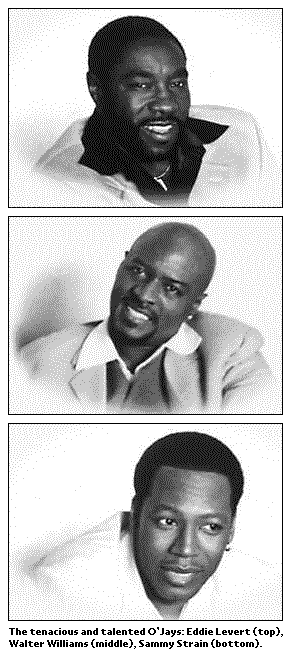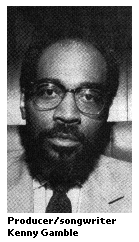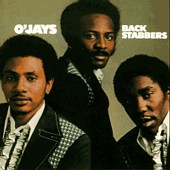"Back Stabbers"
The O'Jays
Philadelphia International 3517
Aug. 1972
Billboard: #3



 ust like Chess Records had passed its crown to Motown ten years earlier, in the early Seventies it was time for Motown to surrender its star to the Philadelphia International label. After losing its identity following its move from Detroit to California, and with its corporate tentacles spread much too wide for any type of musical consistency, Motown was on the decline. Stax Records had never properly recovered after the death of Otis Redding, so it too was out of the running. While these labels were sinking or shifting their fan bases, Kenny Gamble and Leon Huff were on the way up. After working both together and alone as songwriters and session musicians, they eventually began to do freelance production work for some Philadelphia-based R&B artists. Their success compounded until, by 1970, their roster included the Three Degrees, the Vibrations, Billy Paul, and longtime veterans of the R&B/doo-wop scene Harold Melvin and the Blue Notes (including Teddy Pendergrass) and the O'Jays.
ust like Chess Records had passed its crown to Motown ten years earlier, in the early Seventies it was time for Motown to surrender its star to the Philadelphia International label. After losing its identity following its move from Detroit to California, and with its corporate tentacles spread much too wide for any type of musical consistency, Motown was on the decline. Stax Records had never properly recovered after the death of Otis Redding, so it too was out of the running. While these labels were sinking or shifting their fan bases, Kenny Gamble and Leon Huff were on the way up. After working both together and alone as songwriters and session musicians, they eventually began to do freelance production work for some Philadelphia-based R&B artists. Their success compounded until, by 1970, their roster included the Three Degrees, the Vibrations, Billy Paul, and longtime veterans of the R&B/doo-wop scene Harold Melvin and the Blue Notes (including Teddy Pendergrass) and the O'Jays.
 Gamble and Huff named their creative venture Philadelphia International Records. Updating the sound of their highly talented but (mostly) dated acts was their unenviable task, but boy, oh boy, did they ever get the job done. The Blue Notes and the O'Jays had both enjoyed years of modest success before their affiliation with Philadelphia International, but their signing with Gamble and Huff caused them to be among the hottest acts in the country. In 1972 and 1973, each band enjoyed a pair of Top 10 hits.
Gamble and Huff named their creative venture Philadelphia International Records. Updating the sound of their highly talented but (mostly) dated acts was their unenviable task, but boy, oh boy, did they ever get the job done. The Blue Notes and the O'Jays had both enjoyed years of modest success before their affiliation with Philadelphia International, but their signing with Gamble and Huff caused them to be among the hottest acts in the country. In 1972 and 1973, each band enjoyed a pair of Top 10 hits.
 | Released in Sept. 1972, The O'Jays' Back Stabbers album peaked at #10 on the Billboard Hot 200 and remained on the charts for 44 weeks. A second single from the album, "Love Train," topped the US charts in Jan. 1973. |
|  |
A good deal of credit must go to the studio-musician collective known as M.F.S.B. (for Mother-Father-Sister-Brother -- or maybe something a bit raunchier). The team of creative minds who worked at P.I. made sure that the material was good, the arrangements strong, and the production solid. Besides producing, Gamble and Huff were also talented songwriters. Gene McFadden and John Whitehead were producers who got the writing bug after watching Gamble and Huff work. They would later become recording artists in their own right. Thom Bell was another resident genius who, along with Linda Creed, was busy writing and producing the retro-soul of the Stylistics and Delfonics, bands that developed a gentle, falsetto-based sound that owed a debt to doo-wop and was popular as both mellow soul and easy listening. Bell's usual responsibility was to write the lush accompaniment for each production. For "Back Stabbers," the whole gang chipped in to give the label and the O'Jays their first big hit. Huff, McFadden, and Whitehead wrote the song (it was the first tune that McFadden and Whitehead had ever written), the O'Jays sang, Thom Bell arranged the strings and horns, and Gamble and Huff produced.
Dance rhythms, orchestral arrangements, and topical lyrics defined the typical P.I. hit. "Back Stabbers" had all three, with a clean, precise production that was an astonishing update from earlier O'Jays recordings. Upbeat, slick, and soulful, Philadelphia International almost single-handedly laid the groundwork for the coming disco craze. By exaggerating the first two characteristics and ignoring the third, disco would virtually take over popular music during the mid-'70s. A song like "The Hustle" by Van McCoy would utilize the rhythms and arrangement methods that the P.I. staff typically incorporated while sticking to the innocuous phraseology of dance music: "DO THE HUSTLE!" Paradoxically, disco fans would eventually dismiss much of the Philadelphia International material as being too old-fashioned while people who despised the new style lumped most of the P.I. artists into the often misunderstood and much-maligned disco category. To this day, it is hard for some fans to delineate between what was innovative, such as "When Will I See You Again" by the Three Degrees, and what was derivative, like "Fly, Robin, Fly" by Silver Convention.
Eddie Levert, Walter Williams, and William Powell were the O'Jays until 1975, when Powell was replaced by Sammy Strain. With fourteen years of experience before "Back Stabbers" (they formed in 1958), it was fair to say that the O'Jays were no spring chickens at the time of their first monster hit. Amazingly, they beat the obsolescence that other P.I. acts suffered as disco developed, and they continued to enjoy a hit-studded career all the way into the '90s. As tenacious as they are talented, the O'Jays are a musical institution with four decades of history, seven Top 10 hits on the pop charts, and ten #1 hits on the R&B charts to prove it.
- Thomas Ryan, American Hit Radio, Prima Entertainment, 1996.
 Reader's Comments
Reader's Comments
No comments so far, be the first to comment.


 Gamble and Huff named their creative venture Philadelphia International Records. Updating the sound of their highly talented but (mostly) dated acts was their unenviable task, but boy, oh boy, did they ever get the job done. The Blue Notes and the O'Jays had both enjoyed years of modest success before their affiliation with Philadelphia International, but their signing with Gamble and Huff caused them to be among the hottest acts in the country. In 1972 and 1973, each band enjoyed a pair of Top 10 hits.
Gamble and Huff named their creative venture Philadelphia International Records. Updating the sound of their highly talented but (mostly) dated acts was their unenviable task, but boy, oh boy, did they ever get the job done. The Blue Notes and the O'Jays had both enjoyed years of modest success before their affiliation with Philadelphia International, but their signing with Gamble and Huff caused them to be among the hottest acts in the country. In 1972 and 1973, each band enjoyed a pair of Top 10 hits.
